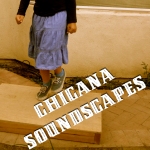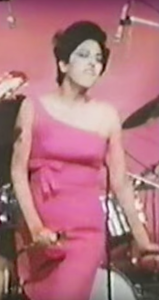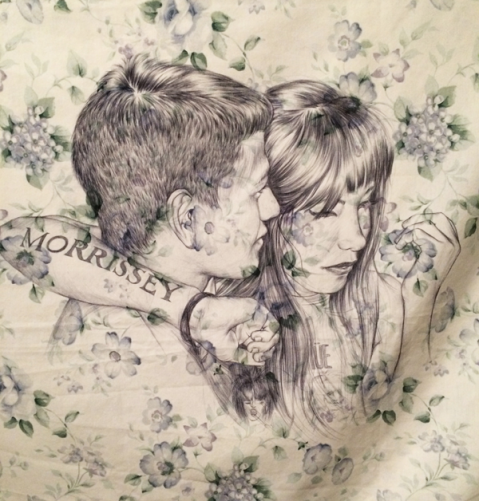“Don’t Be Afraid to Pogo!”: Chicana Hollywood Punks Negotiate ‘h/Home’ After Hardcore Takes L.A.

 For the full intro to the forum by Michelle Habell-Pallan, click here. For the first installment by Yessica Garcia Hernandez click here. For the second post by Susana Sepulveda click here. For the third post by by Wanda Alarcón click here. For last week’s post by Iris C. Viveros Avendaño click here.
For the full intro to the forum by Michelle Habell-Pallan, click here. For the first installment by Yessica Garcia Hernandez click here. For the second post by Susana Sepulveda click here. For the third post by by Wanda Alarcón click here. For last week’s post by Iris C. Viveros Avendaño click here.
The forum’s inspiring research by scholars/practioners Wanda Alarcón, Yessica Garcia Hernandez, Marlen Ríos-Hernández, Susana Sepulveda, and Iris C. Viveros Avendaño, understands music in its local, translocal and transnational context; and insists upon open new scholarly imaginaries. . .
Current times require us to bridge intersectional, decolonial, and gender analysis. Music, and our relationship to it, has much to reveal about how power operates within a context of inequality. And it will teach us how to get through this moment. –MHP
—
When did punk become white? Sound white? Sound male, even? The story of moshing–a dance where predominantly young men gather in a half circle aggressively pushing into each other –which is integral to how the history of punk is shaped, understood, and passed on, offers a window into investigating the outright erasure of Chicana punk from broader punk history which has generally centered cis-heterosexual men from either the U.K. or New York scenes.
Yet, the story of slam dancing, later known as moshing, was also not always a part of punk. In the early 80s slam dancing was introduced by Orange County punks to the Hollywood/ LA scene and through the advent of technologies such as the VHS and Betamax, punk then consequently becomes satirized, recorded, and archived as angry, white, and “Hardcore.”
I argue that the erasure of the Los Angeles punk scene and queer Chicanx youth from punk history can be mapped through the story of when and how the pogo was replaced by slamming. I position the Los Angeles punk scene of the late 1970s and early 1980s as a prime example of how the experiences of punk youth were deeply shaped by the conditions of possibility the pogo offered, creating a completely different scene than the ones more popularly archived as white, male, and devoid of queer people of color and women. Here, gentrification takes the noisy and rapid shape of upper- to middle-class OC Hardcore beach punks introducing slamming and eventually pushing out the pogo –– mirroring the co-optation of L.A. punk and finally cementing the story of US Punk as white. Therefore, the genealogies of these punk dances demonstrate the ways that dance and sound together can produce the gentrification and expulsion of an entire scene.
Pogoing, the predecessor to moshing, as a physical dance consisted of jumping up and down with varying degrees of contact danced usually by participants across venue space. The pogo’s movements embodied a kind of fun that was quite equitable across gender expressions and sexualities. I put this thesis into practice every time I ask my students to pogo with me in class, mainly because literature on the pogo is very scarce and recreating the pogo through movement serves as a pedagogical tool. The pogo was a common form of punk dancing in the earlier days of punk and can be seen more prominently in The Punk Rock Movie (1980), The Great Rock and Roll Swindle (1980), and Decline of Western Civilization (1981).
Though pogoing goes as far back at the U.K scene, it reached the L.A. scene last, just before it became slamming. Broader than a dance, the pogo signified a particular relationship between sound, community and a sense of belonging––a home for the outsider and their band of misfit friends, a home that created space for queer Chicanx/POC youth later forced to reckon with a new wave of punks wearing Swastika patches as eviction notices on their sleeves. The band X said it best on an interview with NPR’s Fresh Air.
X NPR Interview with Terry Gross, 2 May 2016, “A Personal History Of L.A. Punk: ‘It Was A Free-For-All For Outcasts'”
Singer Exene Cervenka explained how the pit formed following a trajectory of spontaneous punk dancing, which includes the pogo, that blurred the lines between audience and performer, particularly during a time where punk was not yet under the scrutiny or rubric of what it meant to be “punk.”
While the pogo was still relatively aggressive by many accounts, according to the late MTV program UltraSound, pogoing began as a response to mainstream Disco’s “the bump” or “the hustle.” These dances signified order and more broadly a celebration of U.S. mass consumer culture that punks from the U.K. and U.S. desired to resist. Though positioning the pogo as a direct response to disco can be deeply racialized–as disco initially was a queer, brown musical movement before mass marketing brought it beyond underground urban dance clubs to the white suburbs– I would rather look to to the pogo’s embodiment of an era of punk in the U.S., with a focused gesture to L.A. punk, that existed before hardcore. Susana Sepulveda defines hardcore as an intensified version of 1970s punk coming out of the local beach cities and commemorated by white cis men despite hardcore’s queer and POC ties from earlier scenes, especially via L.A. I would also add a class analysis, in which hardcore was welcome to upper to middle class punks unlike the scenes before that catered to poor whites and people of color. Yet, the question of how punk became white through the arrival of hardcore and the push back from Chicanx youth, I argue, meet in the pit.
Slam dancing, the predecessor to the mosh pit, is described by Joe Ambrose, as the accompaniment to hardcore shaped by its fast pace and as an expression of male youth aggression that includes a mix of the pogo, circle pitting, and stage diving. Slamming, unlike the pogo, is gendered as predominantly male and performed at the front and center of the stage. Ambrose maps the history of mosh pit by placing slamming as the main dance of the 1970s scenes, with very little attention to the pogo. Yet, I posit slamming as a variant of the pogo that was more violent and reflective of the anxieties and frustrations of upper to middle class white punks. And as a reactionary dance rooted in a bourgeois definition of boredom which punks before them could not afford, since boredom was for them rooted in poverty.
Yet, Ambrose’ erroneous conflation of slamming and the pogo is challenged by various L.A. punks, who have specifically pinpointed the moment they witnessed slamming taking over. Decline of Western Civilization, the aforementioned documentary featuring many queer/POC artists, allows the viewer to bear witness to the act of sound and dance used as a form of gentrification. The Bag’s performance of “Gluttony” and “Prowlers in the Night” alongside FEAR’s “I Don’t Care About You” demonstrates an evolving kind of bodily relationship with the sound of punk, one that began to incite and accommodate the sounds of hardcore through more violent touching and a gendered/racial divide on the dancefloor informed by the slam dance. I expand on Michelle Habell-Pallan’s analysis of Alice Bag’s performance in Decline by adding on how her hot pink mod dress is not just a marker of her unapologetic femininity but also as an unwavering reminder of the long time Chicana residency within L.A. punk unbothered by the misogyny and racism of hardcore, even as its encroachment intensified.
In the chapter “Hard To The Core” from her memoir Violence Girl, Bag recounts how the new wave of younger punks from the Southern California beach cities took over the scene and disinvested in punk as a creative and generally inclusive musical space. Just like Bag, Jello Biafra of the Dead Kennedys also recognized that slamming helped sever the connection between audience and performer, writing the song “Nazi Punks Fuck Off” to call out the dance’s connection between whiteness, heteromasculinity, and violence that was rapidly and radically changing the scene. As he told the LA Times in 2012:
I wrote that song in 1981, and at the time, it was aimed at people who were really violent on the dance floor; they didn’t call it mosh pits yet. It began to attract people showing up just to see if they could get in fights in the pit or jump off stage and punch people in the back of the head and run away.
Drawing from Bag and Biafra, I argue the pogo then also ceased to serve as a conduit for community and home for its LA initiators. OC/Beach punks finally drove out the Hollywood scene by relying on slamming as a classed expression of boredom, antipathy, and anti-patriotism fueled by the Reagan administration, which were all aspects later exploited within mainstream popular culture and through the advent of talk shows. As early as 1982, this wave of coverage created moral panics within conservative American white families about punk rock––finally cementing punk as white and violent.
The process of gentrification is most often perceived as a relatively quiet process where changes to an entire landscape are made against the demands of the community being affected. Yet, the threat and aftermath of gentrification also affects music, such as punk, that is particular to working class artistic spaces. Delinking gentrification as exclusively spatial and analyzing it as also a sonic force of expulsion can help us understand how public access to the arts and music making can be quickly demolished and replaced with new forms of expressive art symbolizing the modern day eviction notice. If the music, and its music makers, and its scene participants no longer have a home within the city, how then can any artistic expression survive in the face of displacement? How does the process of gentrification facilitate the pushing out of already existing music practices, the pogo, while simultaneously allowing windows for gentrification’s beneficiaries to replace and redefine an entire soundscape? Yet, the ways that dance in particular is also affected by gentrification are central to understanding how the eviction of the pogo, and its replacement replaced by slamming, reveals yet another gentrifying force that is not just physical demolition but a palpable vibrational form of sound and dance.

1980 flyer from the East LA punk club The Vex featuring The Brat and Los Illegals.
Although the legacy of care from the pogo has transcended into what we now know as “pit etiquette,” the mosh pit has made its home within punk and much like the process of gentrification, is secured at the expense of the communities that came before it. Thus, I look to the the current struggles of Mariachis in Boyle Heights to analyze gentrification as not just the displacement of a community or neighborhood, but also as a contemporary reminder that the attack on Latinx artistic practices is both ongoing and deeply rooted in Los Angeles history. The resilience of Chicana/Latina soundscapes today attests to our D.I.Y/Do It Yourself tools of recovery, testimonio, sonic and physical nepantlerisma or sonic in-betweenness that made it possible for me to share my interpretation of what happened to the pogo, a side of Chicanx L.A. history that neither physical demolition, hipsters, or even the current political climate can take away.
—
Featured Image: Alice Bag in mid-pogo, at Cinco de Mayo show, 2007. Lysa Flores on guitar.
—
Marlen Ríos-Hernández is a Ph.D. Candidate in the Ethnic Studies Department at the University of California, Riverside. Her current research revolves around queer Chicana/Mexicana punks in Mexico and Los Angeles from 1977-early 2000s. Her dissertation aims to theorize and argue how Alice Bag, an innovator of the 1970s Los Angeles punk scene alongside other Mexicana punks, utilized noise to correlate the systemic disenfranchisement of womxn of color with the desire for transformational change integral to the survival of Mexicanas and first generation Chicana womxn, especially during the Reagan and Bush Administrations. Via Ethnic Studies as her area of study along with her humanities and arts training as a Musicologist, Marlen investigates the relationship between unruly Chicana/Mexicana performing bodies and bisexuality, swapmeets, police brutality, photography, and film as instruments of noise-making necessary to invert normative gender and sexual politics in punk.
—
 REWIND! . . .If you liked this post, you may also dig:
REWIND! . . .If you liked this post, you may also dig:
If La Llorona Was a Punk Rocker: Detonguing The Off-Key Caos and Screams of Alice Bag – Marlen Ríos-Hernández
Riot-Grrrl, Punk and the Tyranny of Technique – Tamra Lucid
An Evening with Three Legendary Rebel Women at Le Poisson Rouge, January 27, 2017: Margot Olavarria, Bibbe Hansen, and Alice Bag –Elizabeth K. Keenan


























Recent Comments